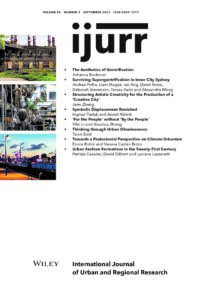In 1988 a local homeowner in Washington, DC, commissioned a 30-foot mural of an artwork by modernist painter Piet Mondrian on the side of a public housing building, along with several other similar murals across the street. Three months later all the residents of the public housing development were moved out. Later, the buildings were destroyed. Here I explore how these murals enabled the residents’ permanent displacement. Explaining this displacement and destruction by pointing to the federal Housing Opportunities for People Everywhere (HOPE) VI policy is completely insufficient. I argue for looking beyond the conventional actors in policy history to other actors, such as, but not limited to, aesthetics, art, artists and art purveyors. I examine Mondrian’s years in Paris, during which he developed his abstract art and philosophy of spiritual evolution, white supremacy and total urban renewal. The homeowner brought Mondrian’s art and philosophy to Washington, DC, at a time of an ideological shift towards global revanchism and gentrification. These specific murals reveal the settler colonial nature of gentrification in confrontation with anti-colonial art and geographies. This study provides new insight into gentrification by illuminating the battles of multiple globalizations in cities and even on individual blocks.

